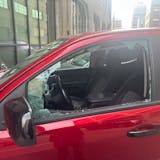The Minnesota Vikings want to know how loud is loud at U.S. Bank Stadium.
"In our short stay so far, it's been pretty good," veteran linebacker Chad Greenway said.
The team has played three games in the huge new $1.1 billion arena, nearly twice the size of the Metrodome it replaced. The Vikings (5-2) won all three home games in resounding fashion, but after dropping the last two road games, coach Mike Zimmer said at his post-practice news conference Friday, "We need our fans to be loud."
Anecdotal assessments by fans, journalists, coaches and players indicate it gets hard to hear everywhere in the stadium — from concourses to the field, seats and the press box. Random, unscientific sound tests around the stadium back that notion.
But for the next two home games — noon Sunday vs. the Detroit Lions, and Nov. 20 vs. the Arizona Cardinals — Minneapolis-based Parsons Electric will set up equipment in two locations to test sound levels. The Vikings will review the results before deciding what sort of tests to run when the Dallas Cowboys come to town on Dec. 1, said Bryan Harper, team vice president for content and production.
"We can already be proud of the building and how loud it is," Harper said. Nevertheless, he added, "We want an answer beyond, 'Yeah, it's really loud in there.' "
Noise connoisseurs
The critical variable is team performance. The better the play, the louder the fans.
Vikings fans, Zimmer said, are "extremely educated and extremely loud, especially when we do good things."


